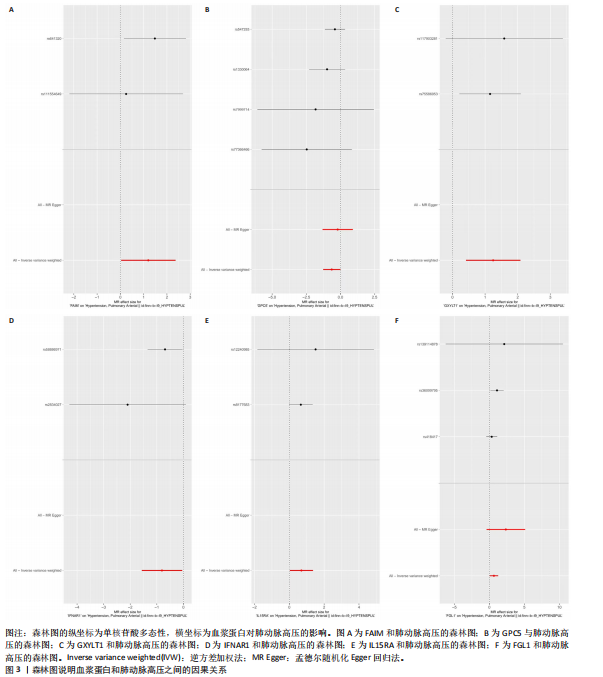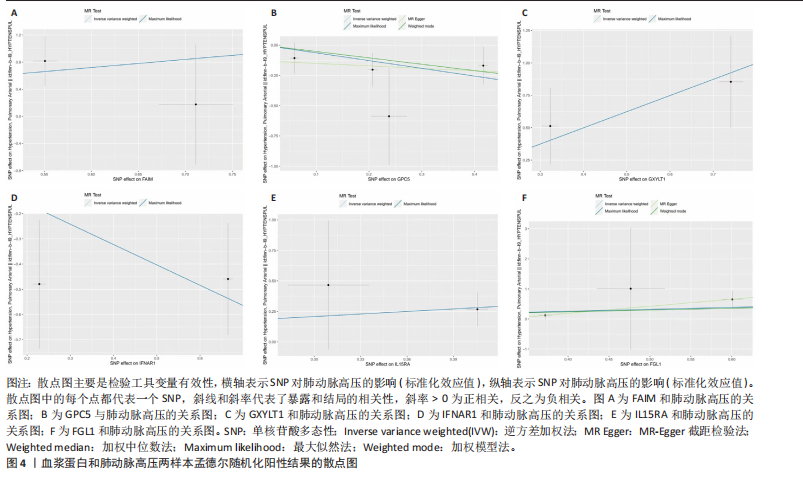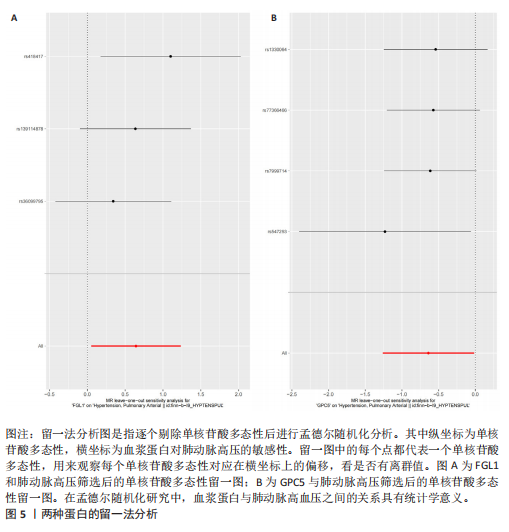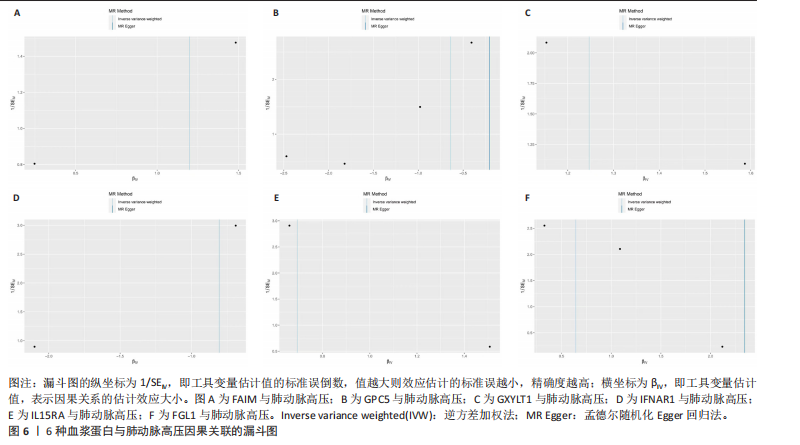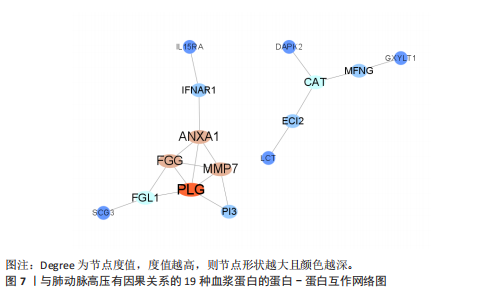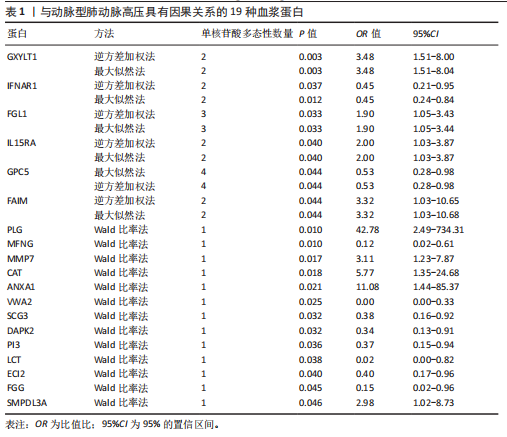[1] 王士伟,康龙丽.动脉型肺动脉高压治疗研究进展[J].中山大学学报(医学科学版), 2024,45(4):493-502.
[2] RUOPP NF, COCKRILL BA. Diagnosis and Treatment of Pulmonary Arterial Hypertension: A Review. JAMA. 2022; 327(14):1379-1391.
[3] ALAMRI AK, MA CL, RYAN JJ. Novel Drugs for the Treatment of Pulmonary Arterial Hypertension: Where Are We Going? Drugs. 2023;83(7):577-585.
[4] LAI YC, POTOKA KC, CHAMPION HC, et al. Pulmonary arterial hypertension: the clinical syndrome. Circ Res. 2014;115(1):115-130.
[5] GUIGNABERT C, TU L, LE HIRESS M, et al. Pathogenesis of pulmonary arterial hypertension: lessons from cancer. Eur Respir Rev. 2013;22(130):543-551.
[6] WEATHERALD J, BOUCLY A, PETERS A, et al. The evolving landscape of pulmonary arterial hypertension clinical trials. Lancet. 2022;400(10366):1884-1898.
[7] SUN BB, MARANVILLE JC, PETERS JE, et al. Genomic atlas of the human plasma proteome. Nature. 2018;558(7708):73-79.
[8] ZHANG M, ZENG Q, ZHOU S, et al. Mendelian randomization study on causal association of IL-6 signaling with pulmonary arterial hypertension. Clin Exp Hypertens. 2023;45(1):2183963.
[9] TAN JS, YANG Y, WANG J, et al. Diabetes mellitus, glycemic traits, SGLT2 inhibition, and risk of pulmonary arterial hypertension: A Mendelian randomization study. Biosci Trends. 2024;18(1):94-104.
[10] PIERCE BL, AHSAN H, VANDERWEELE TJ. Power and instrument strength requirements for Mendelian randomization studies using multiple genetic variants. Int J Epidemiol. 2011;40(3):740-752.
[11] GUDJONSSON A, GUDMUNDSDOTTIR V, AXELSSON GT, et al. A genome-wide association study of serum proteins reveals shared loci with common diseases. Nat Commun. 2022;13(1):480.
[12] DAVEY SMITH G, HEMANI G. Mendelian randomization: genetic anchors for causal inference in epidemiological studies. Hum Mol Genet. 2014;23(R1):R89-98.
[13] FERKINGSTAD E, SULEM P, ATLASON BA, et al. Large-scale integration of the plasma proteome with genetics and disease. Nat Genet. 2021;53(12):1712-1721.
[14] KURKI MI, KARJALAINEN J, PALTA P, et al. FinnGen provides genetic insights from a well-phenotyped isolated population. Nature. 2023;613(7944):508-518.
[15] ZHENG J, HABERLAND V, BAIRD D, et al. Phenome-wide Mendelian randomization mapping the influence of the plasma proteome on complex diseases. Nat Genet. 2020;52(10):1122-1131.
[16] ARDLIE KG, KRUGLYAK L, SEIELSTAD M. Patterns of linkage disequilibrium in the human genome. Nat Rev Genet. 2002;3(4): 299-309.
[17] LEWONTIN RC. The Interaction of Selection and Linkage. I. General Considerations; Heterotic Models. Genetics. 1964;49(1):49-67.
[18] PRITCHARD JK, PRZEWORSKI M. Linkage disequilibrium in humans: models and data. Am J Hum Genet. 2001;69(1):1-14.
[19] 梁云.人类基因组中的连锁不平衡方式[J].国外医学(生理、病理科学与临床分册),2005,25(3):247-250.
[20] PALMER TM, LAWLOR DA, HARBORD RM, et al. Using multiple genetic variants as instrumental variables for modifiable risk factors. Stat Methods Med Res. 2012; 21(3):223-242.
[21] BURGESS S, SCOTT RA, TIMPSON NJ, et al. Using published data in Mendelian randomization: a blueprint for efficient identification of causal risk factors. Eur J Epidemiol. 2015;30(7):543-552.
[22] ZHOU S, TAO B, GUO Y, et al. Integrating plasma protein-centric multi-omics to identify potential therapeutic targets for pancreatic cancer. J Transl Med. 2024; 22(1):557.
[23] BOWDEN J, DAVEY SMITH G, HAYCOCK PC, et al. Consistent Estimation in Mendelian Randomization with Some Invalid Instruments Using a Weighted Median Estimator. Genet Epidemiol. 2016; 40(4):304-314.
[24] BOWDEN J, DAVEY SMITH G, BURGESS S. Mendelian randomization with invalid instruments: effect estimation and bias detection through Egger regression. Int J Epidemiol. 2015;44(2):512-525.
[25] GIAMBARTOLOMEI C, VUKCEVIC D, SCHADT EE, et al. Bayesian test for colocalisation between pairs of genetic association studies using summary statistics. PLoS Genet. 2014; 10(5):e1004383.
[26] BAKER SK, STRICKLAND S. A critical role for plasminogen in inflammation. J Exp Med. 2020;217(4):e20191865.
[27] DEFILIPPIS AP, CHERNYAVSKIY I, AMRAOTKAR AR, et al. Circulating levels of plasminogen and oxidized phospholipids bound to plasminogen distinguish between atherothrombotic and non-atherothrombotic myocardial infarction. J Thromb Thrombolysis. 2016;42(1):61-76.
[28] LIJNEN HR. Elements of the fibrinolytic system. Ann N Y Acad Sci. 2001;936:226-236.
[29] FELDREICH T, NOWAK C, FALL T, et al. Circulating proteins as predictors of cardiovascular mortality in end-stage renal disease. J Nephrol. 2019;32(1):111-119.
[30] TIAN Y, ZHAO Q, WU H, et al. VWA2 protein molecular mechanism predicts colorectal cancer: Promoting cell invasion and migration by inhibiting NK cell activation. Int J Biol Macromol. 2024;279(Pt 3):135394.
[31] LEPPER PM, BALS R, WILKENS H. Natural killer cells in pulmonary arterial hypertension: a force on the dim or the bright side? Circulation. 2012;126(9):1020-1022.
[32] ZHAO H, SONG J, LI X, et al. The role of immune cells and inflammation in pulmonary hypertension: mechanisms and implications. Front Immunol. 2024;15: 1374506.
[33] WANG RR, YUAN TY, WANG JM, et al. Immunity and inflammation in pulmonary arterial hypertension: From pathophysiology mechanisms to treatment perspective. Pharmacol Res. 2022;180:106238.
[34] KELLY L, MCGRATH S, RODGERS L, et al. Annexin-A1: The culprit or the solution? Immunology. 2022;166(1):2-16.
[35] IBRAHIM YF, WONG CM, PAVLICKOVA L, et al. Mechanism of the susceptibility of remodeled pulmonary vessels to drug-induced cell killing. J Am Heart Assoc. 2014;3(1):e000520.
[36] ARVIDSSON M, AHMED A, SÄLEBY J, et al. Plasma TRAIL and ANXA1 in diagnosis and prognostication of pulmonary arterial hypertension. Pulm Circ. 2023; 13(3):e12269.
[37] HENNIGS JK, BAUMANN HJ, LÜNEBURG N, et al. Fibrinogen plasma concentration is an independent marker of haemodynamic impairment in chronic thromboembolic pulmonary hypertension. Sci Rep. 2014;4: 4808.
[38] ALAM SR, NEWBY DE, HENRIKSEN PA. Role of the endogenous elastase inhibitor, elafin, in cardiovascular injury: from epithelium to endothelium. Biochem Pharmacol. 2012; 83(6):695-704.
[39] WANG J, SANMAMED MF, DATAR I, et al. Fibrinogen-like Protein 1 Is a Major Immune Inhibitory Ligand of LAG-3. Cell. 2019;176(1-2):334-347.e12.
[40] THOMAS C, MORAGA I, LEVIN D, et al. Structural linkage between ligand discrimination and receptor activation by type I interferons. Cell. 2011;146(4):621-632.
[41] IVASHKIV LB, DONLIN LT. Regulation of type I interferon responses. Nat Rev Immunol. 2014;14(1):36-49.
[42] RATTHÉ C, GIRARD D. Interleukin-15 enhances human neutrophil phagocytosis by a Syk-dependent mechanism: importance of the IL-15Ralpha chain. J Leukoc Biol. 2004;76(1):162-168.
[43] WU Z, XUE HH, BERNARD J, et al. The IL-15 receptor {alpha} chain cytoplasmic domain is critical for normal IL-15Ralpha function but is not required for trans-presentation. Blood. 2008;112(12):4411-4419.
[44] HUO J, XU S, LAM KP. FAIM: An Antagonist of Fas-Killing and Beyond. Cells. 2019;8(6): 541.
[45] RIZZI M, TSCHAN MP, BRITSCHGI C, et al. The death-associated protein kinase 2 is up-regulated during normal myeloid differentiation and enhances neutrophil maturation in myeloid leukemic cells. J Leukoc Biol. 2007;81(6):1599-1608.
[46] URATA Y, SAIKI W, TSUKAMOTO Y, et al. Xylosyl Extension of O-Glucose Glycans on the Extracellular Domain of NOTCH1 and NOTCH2 Regulates Notch Cell Surface Trafficking. Cells. 2020;9(5):1220.
[47] PENG L, ZHAO M, LIU T, et al. A stop-gain mutation in GXYLT1 promotes metastasis of colorectal cancer via the MAPK pathway. Cell Death Dis. 2022;13(4):395.
[48] SATO C, ZHAO G, ILAGAN MX. An overview of notch signaling in adult tissue renewal and maintenance. Curr Alzheimer Res. 2012;9(2):227-240.
[49] TAKEUCHI A, MIYAMOTO T, YAMAJI K, et al. A human erythrocyte-derived growth-promoting factor with a wide target cell spectrum: identification as catalase. Cancer Res. 1995;55(7):1586-1589.
[50] CHEN L, DAI P, LIU L, et al. The lipid-metabolism enzyme ECI2 reduces neutrophil extracellular traps formation for colorectal cancer suppression. Nat Commun. 2024;15(1):7184.
[51] NÉMETH K, PLUMB GW, BERRIN JG, et al. Deglycosylation by small intestinal epithelial cell beta-glucosidases is a critical step in the absorption and metabolism of dietary flavonoid glycosides in humans. Eur J Nutr. 2003;42(1):29-42.
[52] TRAINI M, QUINN CM, SANDOVAL C, et al. Sphingomyelin phosphodiesterase acid-like 3A (SMPDL3A) is a novel nucleotide phosphodiesterase regulated by cholesterol in human macrophages. J Biol Chem. 2014; 289(47):32895-32913.
[53] SHIN H, CHUNG H. SMPDL3A links cholesterol metabolism to the cGAS-STING pathway. Immunity. 2023;56(11):2459-2461.
[54] TANG F, PACHECO MTF, CHEN P, et al. Secretogranin III promotes angiogenesis through MEK/ERK signaling pathway. Biochem Biophys Res Commun. 2018; 495(1):781-786.
[55] ZHANG H, WANG G, YANG X, et al. Investigation of Gene Expression Profile of A549 Cells after Overexpression of GPC5 by High Throughput Transcriptome Sequencing. Zhongguo Fei Ai Za Zhi. 2016; 19(8):545-549.
|
